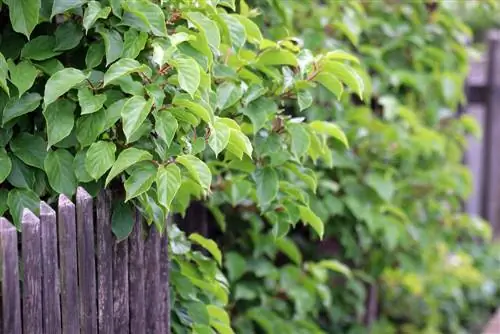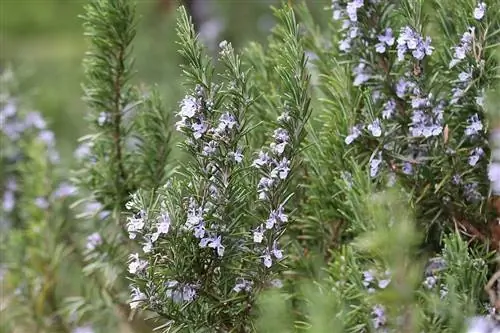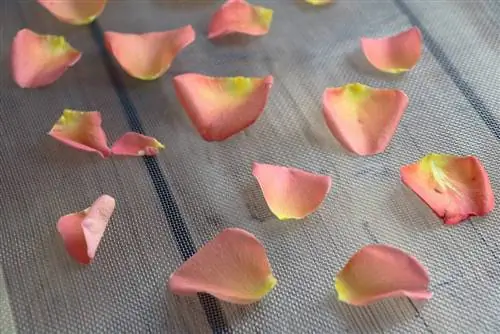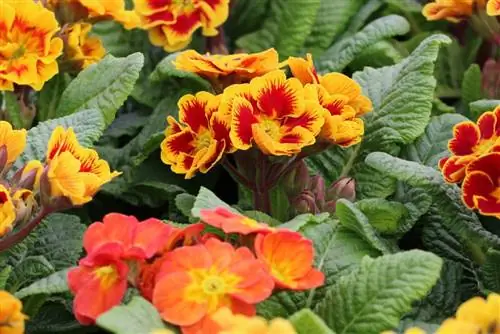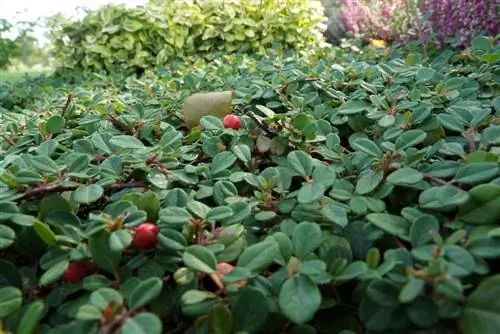- Author admin [email protected].
- Public 2023-12-17 03:39.
- Last modified 2025-01-24 12:45.
The Chinese gooseberry, as the kiwi is also called, can also be grown in the home garden under certain conditions. For the most part, dioecious varieties are offered, i.e. only male or only female, whereby a male can fertilize several females. There are significantly fewer fruiting kiwi varieties. They are male, so-called virgin fruits, which develop fruits even without pollination.
Special features of self-fertile kiwi plants
Fertilization is usually the basis orPrerequisite for lots of delicious and he althy fruits. Theoretically, the self-fruiting kiwi can do without an additional pollinator variety. The self-fertility of these varieties is not actually based on efficient self-fertilization, but rather on the ability of these plants to produce fruit regularly even without a pollinator, which is also the case more or less reliably with the different varieties. But that doesn't detract from their taste.
Tip:
Despite self-fertile properties, experts recommend ensuring pollination with an additional male kiwi variety in order to significantly increase fruit size and fruit yield.
Self-fruitful varieties
Grape or columnar kiwi 'Issai'
The grape kiwi 'Issai' is one of the best-bearing, self-fertile varieties, with good leaf he alth. Among the many varieties of kiwi, this one is a bit different because its grape-like fruits can be eaten with the peel on. In contrast to the classic kiwi, it is smooth. The fruits have a very pleasant, fig-like aroma and taste slightly of wild berries. The grape kiwi 'Issai' has a climbing habit and therefore requires suitable climbing aid. It grows 300-400 cm in height and between 400 and 800 cm in width. Harvest time is from September to October. It blooms, but does not produce reliably every year.
Tip:
If the fruits are overripe, they usually have a floury consistency.
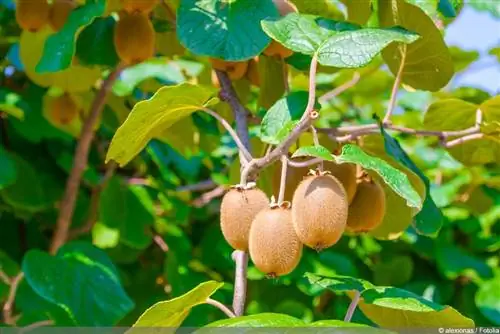
Actinidia deliciosa 'Jenny'/'Yennie'
This self-fruiting variety impresses with its rapid growth, growth heights of up to 500 cm and cylindrical fruits with the typical hairy skin. The delicate cream-colored flowers appear in May/June, from which the aromatic, sweet and sour tasting fruits develop. They can be harvested from mid-October to November. The fruits can be eaten raw but can also be used to make jams. With this variety, too, the additional planting of another self-fertile variety or a male variety can significantly increase the yield.
Actinidia deliciosa ‘Solo’
This robust and high-yielding kiwi produces very good yields for many years in a row in sunny locations. It reaches heights of 300-400 cm and grows between 400 and 800 cm wide. Their twining, upright and bushy growth as well as the double, creamy white flowers also ensure a beautiful look. The up to 4 cm long fruits reach maturity and their characteristic sweet-sour taste towards the end of October.
Large-fruited kiwi 'Solissimo'
Even if fruiting varieties are usually rather heavy-bearing, it can happen that they do not produce fruit despite good flowering. The large-fruited kiwi 'Solissimo' is also a variety. This is because self-fertile kiwi varieties only tend to produce fruit without fertilization and are actually not self-fertile. As a result, they do not wear reliably year after year.
Tip:
Especially with this large-fruited kiwi, it is probably better to choose a different variety and, if not, to plant a male pollinator plant.
Actinidia arguta ‘Julia’
Thanks to its smooth skin, the kiwi Actinidia arguta 'Julia(R)' can be eaten directly from the bush. Under optimal conditions, it sometimes bears fruit in the first or second year. In contrast to many other kiwi varieties, it grows to a maximum height of 300 cm, making it suitable for planting in containers. The considerable size of its fruits of 4-5 cm makes it one of the big ones among the small-fruited kiwi varieties. It reaches its ripeness for consumption and picking and thus its full aroma in September.
Sharp-toothed ray style 'Kokuwa'
The sharp-toothed ray stylus 'Kokuwa' is a Japanese, hermaphrodite mini kiwi. Their smooth-shelled fruits are about 2 cm long and can be enjoyed with the peel on. The plants climb up to 600 cm in height with an annual increase of 100-200 cm. They are ready to harvest in September/October, although flowers and fruit set can be expected after at least 2-3 years.
Actinidia arguta ‘Vitikiwi’
Actinidia argute 'Vitikiwi' also sets seedless fruits regularly and reliably without any pollinator, which works much more reliably with this variety than with the grape kiwi 'Issai'. This seedless berry kiwi produces fruit in the first and second year after planting. They are also smooth-shelled and therefore completely edible. In October they are ripe and can be harvested. Actinidia argute 'Vitikiwi' reaches heights of between 600 and 800 cm. Here too, the proximity of a male plant can increase the yield and also have a positive effect on the size of the fruit.
If the flower fails to bloom
- Depending on the type of cultivation, it can take several years for the first flower to appear
- Mostly five or six, sometimes even ten years
- Only then flowers and significant yields
- If the kiwi does not bloom after this time, several reasons are possible
- For example, excessive pruning and/or fertilization that emphasizes too much nitrogen
- Or the soil is too calcareous or not fertilized at all
- The result can be a lack of trace elements, flowering stops
- Possible flower buds may have fallen victim to late frosts
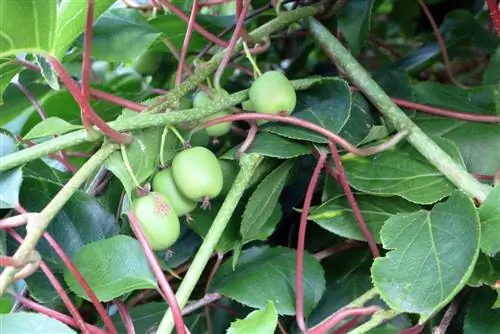
Kiwis generally need acidic, evenly moist soil that should never dry out completely. When choosing the right fertilizer, make sure not to use fertilizers containing chloride and to avoid soils that are too calcareous.
Despite flowers no fruit
If the kiwi finally blooms, that doesn't mean that it will produce fruit. If fruit formation does not occur despite lush flowering, you may have purchased a plant that was bred using so-called in vitro propagation, which is the case with most commercially available plants.
- In vitro propagation also known as meristem propagation
- Applicable plants grown in test tubes or petri dishes
- Plants grown with the addition of hormones
- Plants grown in this way must reach a certain age
- Only then can they produce flowers and fruit
- It could take six, seven or even ten years until that happens
Tip:
The situation is different with plants that have been propagated in the traditional way via cuttings; they usually bloom after 2-3 years.

